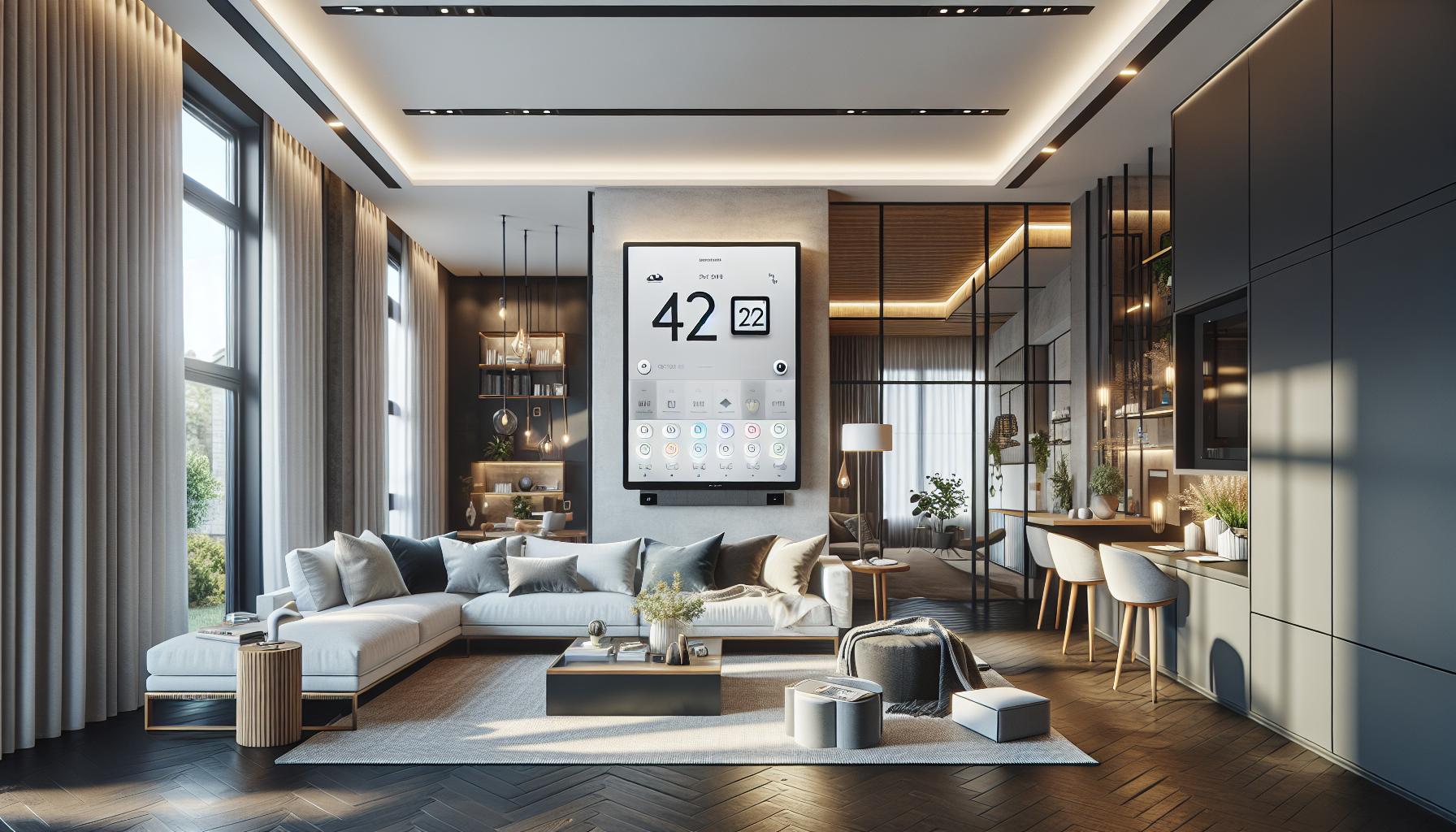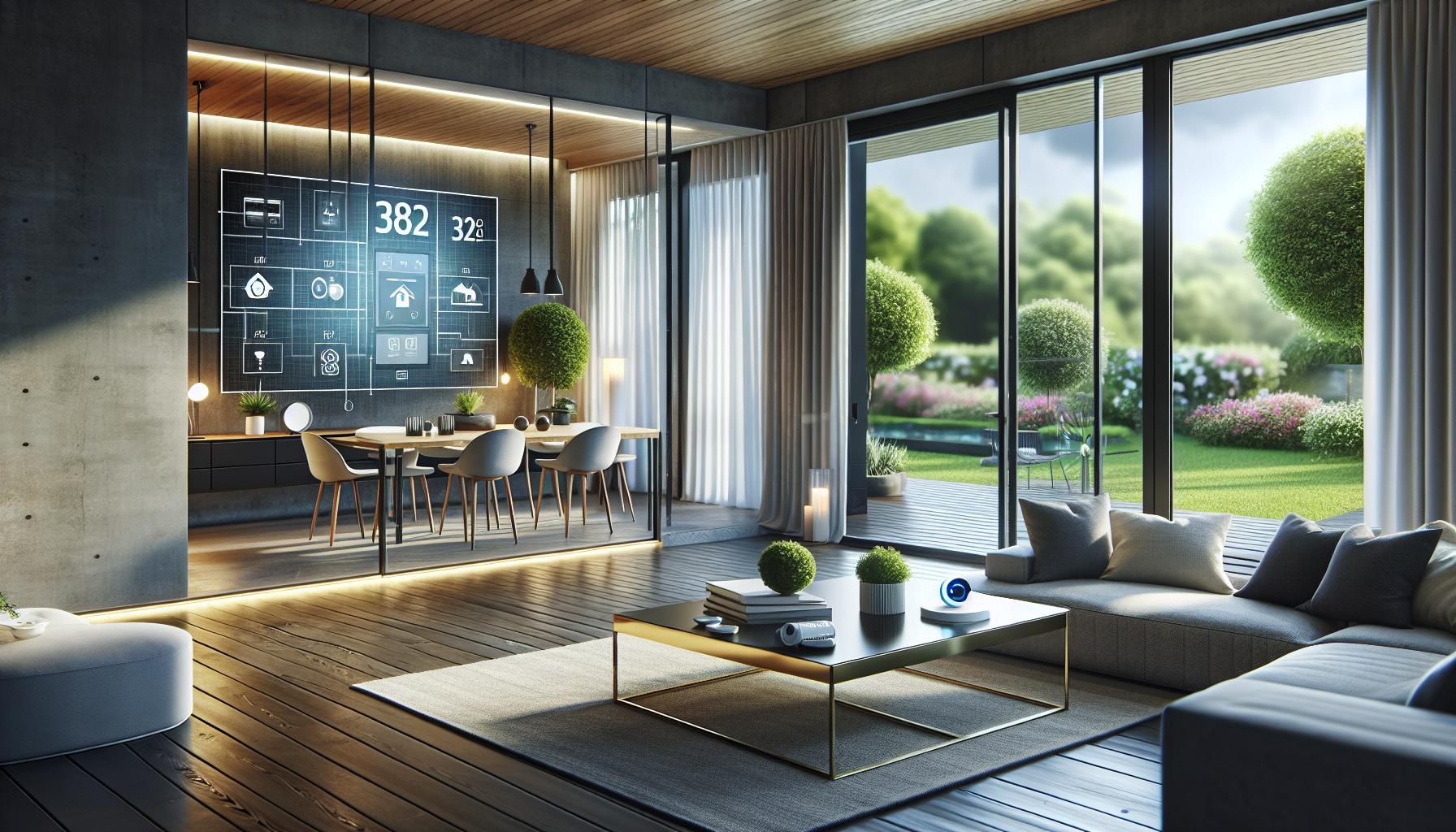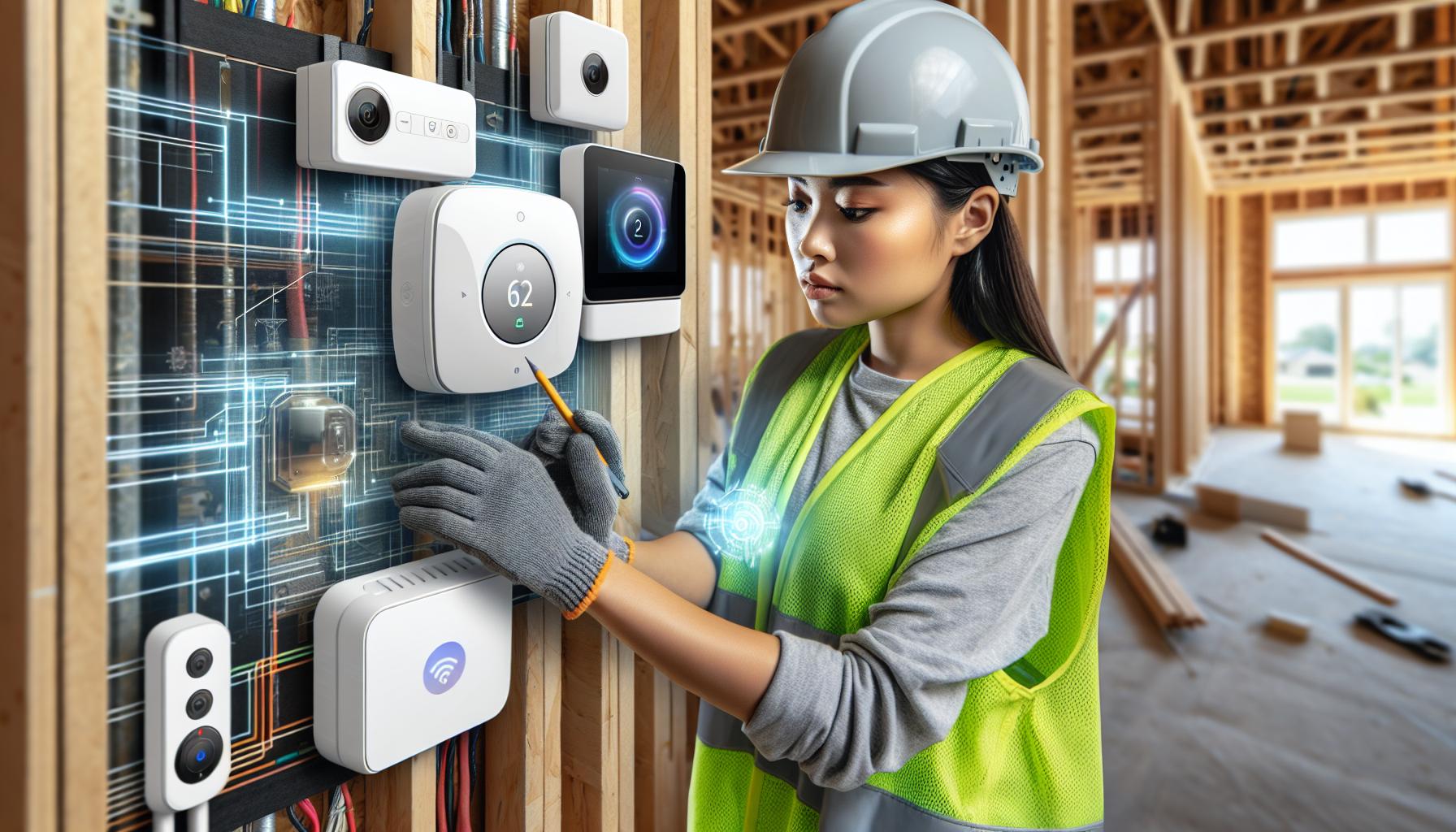Key Takeaways
- Integration of Technology: Smart home technology enhances comfort, security, and energy efficiency in new construction, making it an essential consideration for modern homeowners.
- Energy Efficiency: Smart thermostats and lighting systems can significantly reduce energy bills and environmental impact by optimizing usage based on occupancy and automated controls.
- Enhanced Security: Smart locks, doorbell cameras, and intrusion alarms provide real-time monitoring and alerts, increasing homeowner safety and peace of mind.
- Convenience of Home Automation: Centralized hubs and voice-activated systems simplify home management, allowing users to control multiple devices effortlessly and enhance their daily routines.
- Future Trends: Emphasis on AI, interoperability, and sustainability will drive the evolution of smart home designs, focusing on personalized experiences and advanced energy management solutions.
- Planning and Selection: Proper planning during construction and choosing compatible technology are vital for seamlessly integrating smart features, ensuring a user-friendly and efficient living environment.
In today’s fast-paced world, smart home technology is transforming the way people live. For those embarking on new construction projects, integrating these innovations can elevate both comfort and efficiency. Imagine controlling your lighting, security, and climate with just a tap on your smartphone or a simple voice command.
As homeowners increasingly prioritize convenience and sustainability, smart home features are becoming essential. From energy-efficient appliances to advanced security systems, the possibilities are endless. This article explores exciting smart home ideas that can enhance any new build, ensuring it’s not just a house but a cutting-edge living space tailored to modern needs.
Smart Home Ideas For New Construction
Smart home technology encompasses a range of devices and systems designed to enhance home automation, security, and energy efficiency. This technology enables homeowners to manage different aspects of their living environment through mobile applications, smart speakers, or automated systems. Common features include smart lighting, smart thermostats, and security cameras that provide remote surveillance capabilities.
Smart lighting systems allow users to control brightness and color settings through a smartphone. These systems can be scheduled to adjust automatically based on time of day or occupancy. Smart thermostats optimize energy usage by learning heating and cooling patterns, allowing for programmable comfort adjustments.
Home security is significantly enhanced with the integration of smart locks, doorbell cameras, and security alarms. Users receive real-time notifications about door access and can monitor their property from anywhere through mobile devices.
Smart home technology also improves energy efficiency through smart plugs and appliances that monitor usage statistics. These devices help reduce energy waste by allowing users to track their consumption and make informed decisions.
When applied to new construction, smart home technology provides opportunities to build energy-efficient, user-friendly environments. Homeowners benefit from increased convenience, advanced security measures, and improved energy management, all of which contribute to a modern lifestyle. Smart home features not only enhance the overall functionality of a home, but they also add value and appeal in today’s competitive real estate market.
Benefits of Smart Home Systems

Smart home systems offer practical advantages for homeowners, particularly in new construction projects. These systems improve energy efficiency, enhance security, and create a more comfortable living environment.
Energy Efficiency
Energy efficiency becomes a central focus in smart home design. Smart thermostats adjust heating and cooling based on occupancy patterns, significantly reducing energy bills by up to 30%. Smart lighting systems utilize LED technology and offer automated controls to turn lights off when rooms are unoccupied. Additionally, smart appliances, like refrigerators and washing machines, optimize energy consumption during non-peak hours, further minimizing environmental impact. Homeowners can monitor energy usage in real-time through mobile apps, enabling informed decisions that lead to additional savings.
Enhanced Security
Enhanced security represents another key benefit of smart home systems. Smart locks provide keyless entry and remote access, allowing homeowners to secure their properties from anywhere. Doorbell cameras offer real-time video feeds, sending alerts to phones when motion is detected, enhancing surveillance capabilities. Intrusion alarm systems integrate with smart devices to deliver immediate notifications in case of abnormal activity. Furthermore, motion sensors and security cameras allow for comprehensive monitoring of the home environment, enabling rapid response to potential security threats. This level of control and awareness significantly increases peace of mind for homeowners.
Essential Smart Home Ideas for New Construction

Incorporating smart home technologies into new construction provides enhanced comfort, convenience, and efficiency. Below, key smart home ideas are detailed for an optimized living environment.
Smart Lighting Solutions
Smart lighting solutions significantly enhance energy efficiency and control. Homeowners can schedule lighting patterns, adjust brightness, and change colors through mobile apps or voice commands. Systems like Philips Hue and LIFX allow room-by-room customization, promoting ambiance for various activities. Motion sensors activate lights in hallways or entryways, ensuring safety and reducing wasted energy. Dimmers and smart switches enable automated adjustments based on time of day or occupancy.
Home Automation Systems
Home automation systems simplify daily routines. Centralized hubs, such as SmartThings or Amazon Echo, integrate various devices, allowing unified control. Homeowners can trigger scenes for movie nights or bedtime, adjusting lighting, temperature, and security settings simultaneously. Voice-activated assistants enable effortless control, serving as a command center for connected devices. Additionally, automated window shades provide convenience and energy efficiency by regulating natural light and maintaining privacy.
Smart Thermostats
Smart thermostats optimize energy usage while offering comfort. Devices like the Nest Thermostat and Ecobee learn user preferences and adjust accordingly, leading to potential savings of up to 30% on energy bills. These thermostats offer remote control capabilities through smartphone apps, allowing homeowners to manage their climate when away from home. Geofencing technology automatically adjusts settings based on proximity, enhancing efficiency and comfort without manual intervention.
Advanced Home Security Options
Advanced home security options provide comprehensive protection and peace of mind. Smart locks like August or Schlage offer keyless entry and remote access, allowing homeowners to grant entry to visitors without being home. Doorbell cameras, such as Ring or Arlo, provide real-time video feeds and alerts on mobile devices, enhancing awareness of who approaches the home. Intrusion alarms and motion detectors create layers of security, notifying homeowners of potential breaches and allowing quick responses. Automated security systems can also integrate with local authorities for swift action in emergencies.
Integrating Smart Home Features

Integrating smart home features during new construction enhances convenience, efficiency, and security. Proper planning and selecting the right technology ensure a seamless incorporation of these innovations.
Planning During Construction
Planning plays a crucial role in the effective integration of smart home features. Assessing electrical schematics allows for optimal placement of devices like smart lighting and outlets. Collaborating with contractors ensures proper wiring for smart systems and prevents potential compatibility issues. Incorporating structured wiring can enhance connectivity among devices, creating a robust network for smart home technology. Preparing for future upgrades is beneficial; installing conduits for easy connection updates empowers homeowners to adapt to technological advancements without extensive renovations.
Choosing the Right Technology
Choosing the right technology directly impacts the effectiveness of a smart home system. Prioritize compatibility with popular platforms such as Amazon Alexa, Google Assistant, or Apple HomeKit. Selecting energy-efficient appliances can yield significant savings; for example, a smart refrigerator can reduce energy consumption by up to 20%. Opt for versatile smart thermostats that adjust settings based on occupancy patterns, potentially lowering energy bills by 10-30%. Explore a variety of smart security options, such as connected cameras and smart locks, which enhance property safety. Investing in devices that offer mobile app support promotes user-friendly control and monitoring of home systems, maximizing the overall smart home experience.
Future Trends in Smart Home Design
Smart home design continues to evolve, with several trends expected to shape the future of residential construction. These trends focus on enhancing automation, energy efficiency, and user experience, integrating advanced technology seamlessly.
Increased Use of Artificial Intelligence
Artificial intelligence (AI) becomes a staple in smart home systems, offering predictive capabilities. With AI integration, devices learn from user behavior to provide tailored experiences. For example, smart thermostats adjust settings based on daily habits, optimizing comfort and energy consumption.
Enhanced Interoperability
Interoperability among devices gains importance in future smart homes. A unified platform allows homeowners to control various systems from a single application. Standards such as Matter support compatibility across different brands, simplifying device integration and management.
Expansion of Voice Control
Voice control technology expands, enabling homeowners to manage devices with natural language commands. Virtual assistants like Amazon Alexa and Google Assistant become more sophisticated, allowing for complex interactions and commands. This feature increases accessibility for users of all ages.
Growth of Energy Management Solutions
Energy management solutions will dominate smart home design. Devices will monitor energy usage in real time, providing insights to reduce waste. Homeowners can track consumption patterns through mobile apps, encouraging informed decisions about energy-saving practices.
Focus on Sustainability
Sustainability remains a key trend in smart home design. Energy-efficient appliances and renewable energy sources, such as solar panels, integrate with smart home technology. Homebuilders prioritize eco-friendly materials and systems that promote a reduced carbon footprint.
Increased Security Features
Enhanced security features expand to meet growing homeowner concerns. Smart surveillance systems incorporate AI for real-time threat detection and alerts. Additionally, biometric locks and advanced monitoring applications provide layers of protection and peace of mind.
Personalized User Experiences
Personalized user experiences gain prominence in smart home technology. Homeowners can customize settings for lighting, climate, and security. Profiles based on individual preferences ensure automated adjustments deliver optimal comfort in their living spaces.
Emphasis on Health and Wellness
Health and wellness technology integrates into smart home designs. Air quality monitors and smart humidifiers promote healthier living environments. Additionally, fitness-focused applications can track residents’ health metrics, supporting overall well-being.
Advances in Home Automation
Advancements in home automation continue to simplify lifestyle management. These systems seamlessly integrate appliances, lighting, and climate control. Homeowners enjoy complete control over their environment, fostering convenience and enhancing daily routines.
These trends indicate a shift toward more intelligent, connected, and user-friendly smart home designs. Homeowners benefit from enhanced efficiency, improved security, and a greater focus on sustainability.
Embracing Smart Home Technology in New Construction
Embracing smart home technology in new construction not only elevates living standards but also aligns with modern demands for efficiency and security. As homeowners increasingly seek convenience and sustainability, these innovations play a crucial role in shaping their environments.
By carefully selecting and integrating smart features, builders and homeowners can create a seamless living experience that enhances comfort and optimizes energy use. With advancements in automation and connectivity, the future of home design looks promising, paving the way for smarter, more efficient homes.
Investing in these technologies today ensures that new constructions remain relevant and appealing in an ever-evolving real estate market.